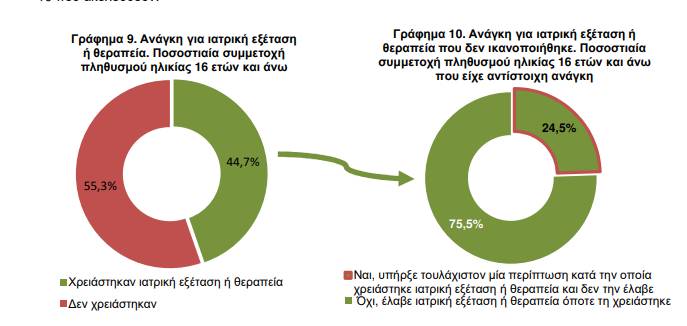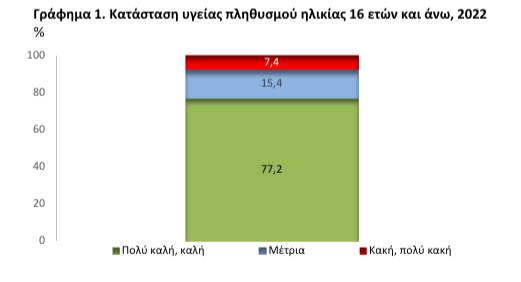Greek Statistical Office ΕΛΣΤΑΤ released a report reflecting the health status of the population aged 16 and over, as well as reporting on the living conditions of the population.
On May 16 of this year, ΕΛΣΤΑΤ released data taken from a study called “Income and Living Conditions of Households in 2022” Νοικοκυριών, του έτους 2022).
The monitoring, which is carried out annually, collects detailed information on the general health status of the population aged 16 years and over, as well as on the use of health services (conducting or not having medical and dental examinations, receiving or not receiving treatment), depending on demographic characteristics (gender and age), education, occupation and family income.
The 2022 survey also collects information on body mass index, the ability of the population aged 16 and over to perform basic functions (vision, hearing, movement, memory/concentration) for factors that influence health status, such as exercise, fruit consumption and vegetables, smoking, alcohol consumption, and the burden of health care costs on Greek households.
What did the results show about the general health of the population
According to the results of the survey, 74.2% of the population aged 16 and over state that they have very good or good health, 15.5% – average and 10.3% – poor or very poor.
Compared with the results of the 2009 survey, there is a slight decrease of 1.2 percentage points in the share of the population reporting very good or good health, and an increase of 0.6 percentage points in the share of the population reporting health as moderate and poor or very poor. both cases.
People with health problems. Changes in their lifestyle
24.9% of the population aged 16 and over have chronic health problems. About 3 out of 10 women (27.0%) and 2 out of 10 men (22.6%) report a chronic problem or condition. For six months or more, 9.0% limited some of their usual activities or experienced great difficulties for health reasons, and 13.2% limited some activities or experienced difficulties in them.
Using the GALI (Global Activity Limitation Indicator) index, it is assessed whether the respondent believes that he restricted due to health problems (physical, mental or emotional) existing condition/disability or due to age dactivities that are usual for him and the general population for 6 months or more.
Limitations due to congenital health problems and accidents/injuries are also included, while limitations due to financial or other reasons are not included.
What is a chronic health problem
- According to Statistics Greece, a health problem or condition that lasts or will continue for more than 6 months, with or without medication, is considered chronic.
- Limitations of physical and sensory functions:
- 13.5% of the population aged 16 and over have vision difficulties (some difficulty, severe difficulty, can’t see anything).
- 78.8% of those aged 65 and 11.0% of the population aged 16 and over are hard of hearing (some difficulty, great difficulty, can’t hear anything). 86.6% of them are aged 65 years.
- 15.8% of the population aged 16 and over experience mobility difficulties (some difficulty, great difficulty, inability to walk or go up/down stairs without the use of some kind of help or assistance from another person). 74.4% of them are aged 65 and over.
- 11.6% of the population aged 16 and over have memory/concentration difficulties (some difficulty, great difficulty, remember nothing or cannot concentrate on what they are doing).
- 82.5% of them are aged 65 and over. 8.0% of the population aged 16 and over experience difficulties with self-care (some difficulties, great difficulties, inability to take care of themselves, for example, washing clothes, dressing themselves, etc.). 78.1% of them are aged 65 and over.
- 4.7% of the population aged 16 and over experience difficulties in communicating with other people (some difficulties, great difficulties, not understanding them, despite the fact that people speak the same language). 70.1% of them are aged 65 years.
Use of medical services
- In the last 12 months prior to the study, approximately one in two (44.7%) adults aged 16 years and over required medical examination or treatment.
- 24.5% of those who needed medical examination or treatment did not receive it.
- 19.3% of the poor population aged 16 and over did not receive medical examination or treatment, although they needed it. The corresponding percentage of the non-poor population is 8.9%.

Use of care services – medication consumption
The study collected information on the use of health care services, in particular overnight hospitalizations and use of care services (nursing or other) in the home, as well as the percentage of the population aged 16 and over who use drugs.
Research results:
- In the last 12 months prior to the study, the proportion of the population aged 16 years and older who were hospitalized overnight was 9.3%. The number of days of hospitalization ranged from 1 to 180.
- 62.2% of the population were hospitalized from 1 to 5 days, and more than 5 and up to 10 days – 25.1%.
- The survey recorded information about home care services provided to older people (who suffer from chronic diseases or health problems) and who need care.
- Nursing services provided by health professionals (nurse, pharmacist, nutritionist, physiotherapist, etc.) or social services were also taken into account. It is noted that home visits of doctors not included in the study.
- Non-nursing care may be provided by unskilled people working or volunteering in a formal program while home care from family or friends is not included.
- In the last 12 months prior to the survey, 3.2% of the population aged 16 years and over used home care services.
- In the two weeks leading up to survey day, one in two (46.2%) consumed prescription drugs, herbal remedies (Supplements) or vitamins. The study included medications consumed during the above time period and previously prescribed by a physician (for example, in connection with ongoing treatment).







More Stories
Why cats don't go to your hands and don't like to be petted
When does old age begin? The answer to this question changes with age.
Association of Professional Nutritionists to be created in Greece